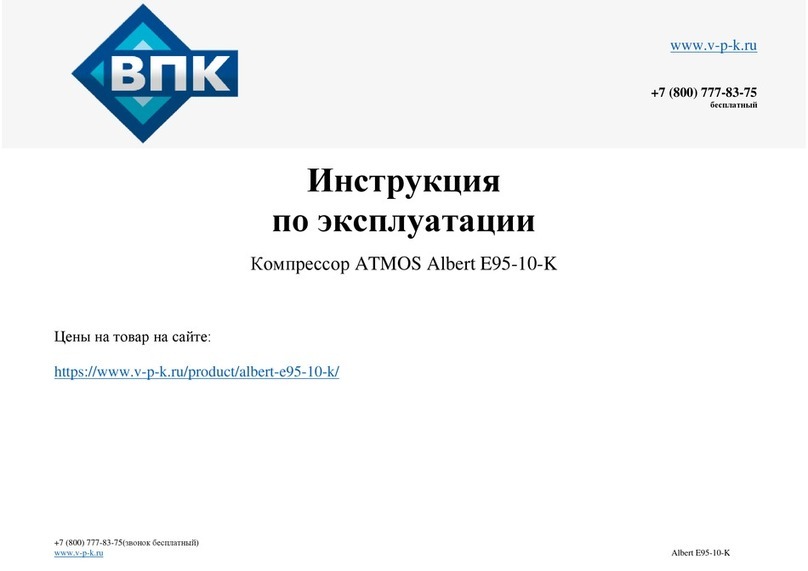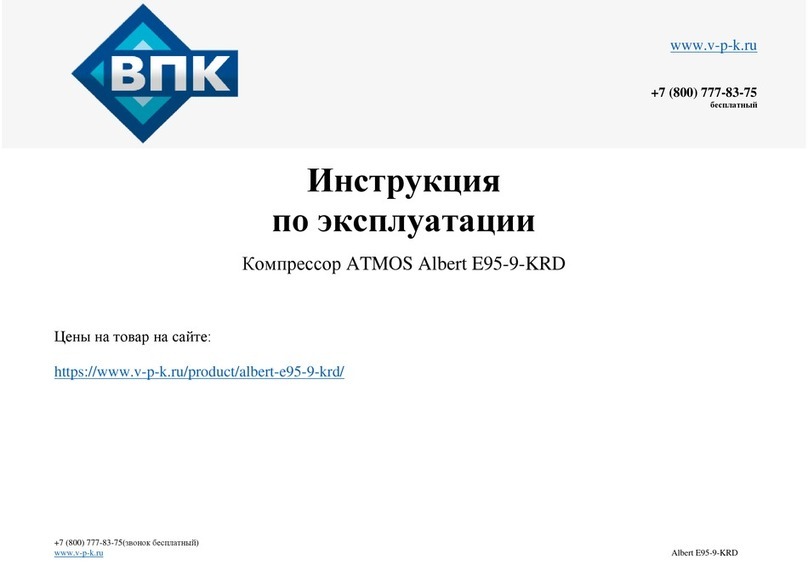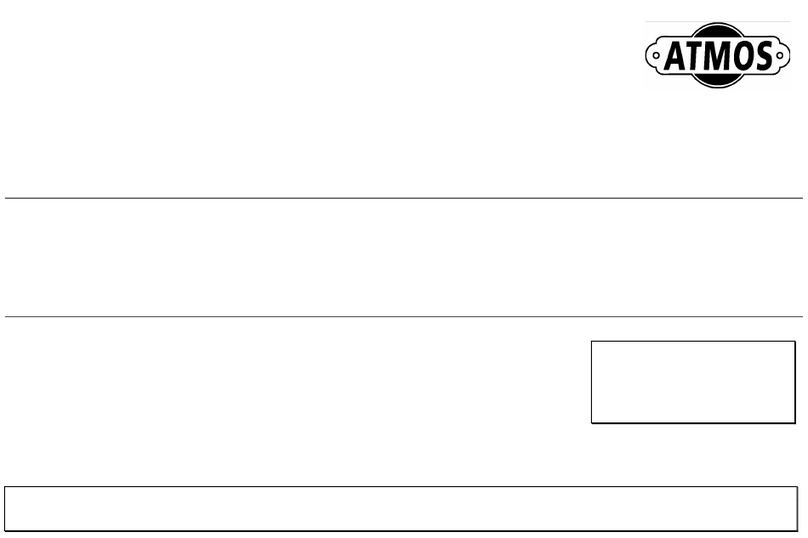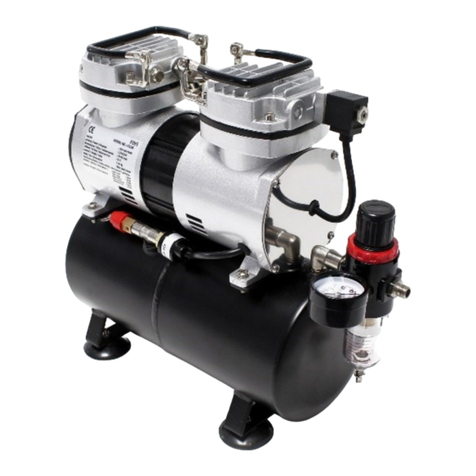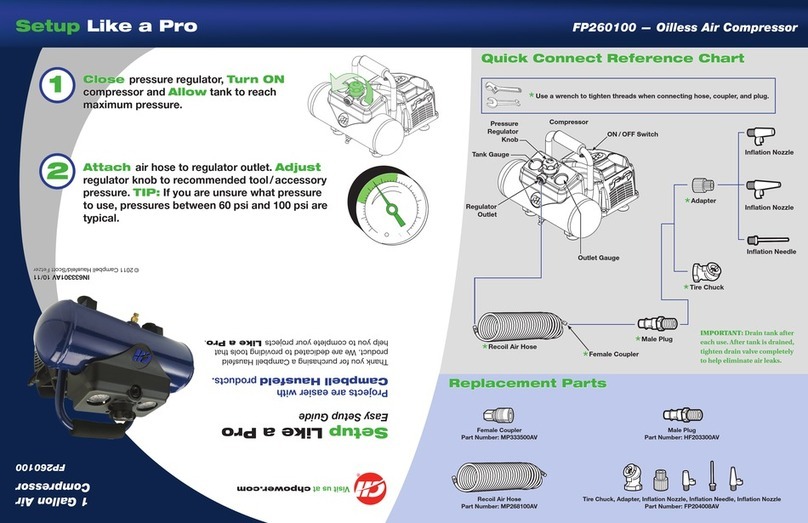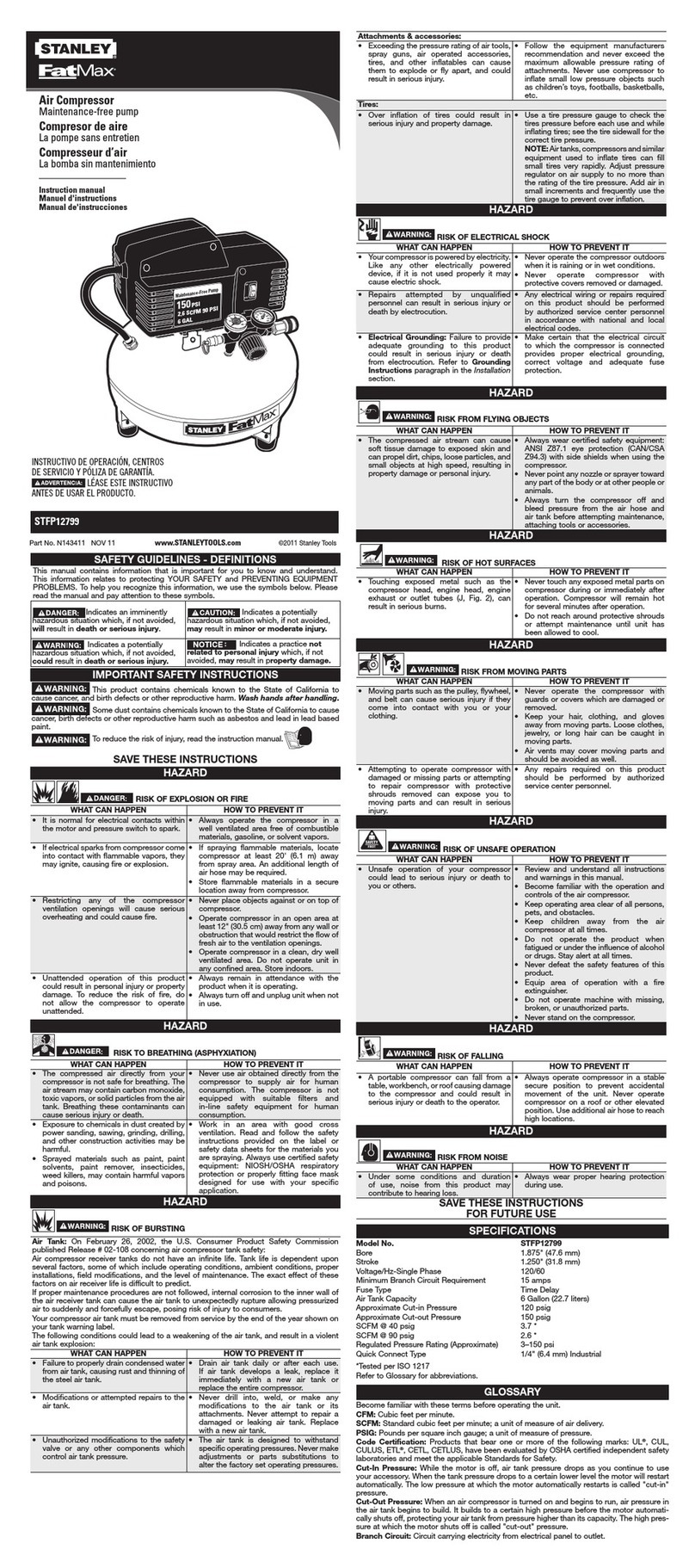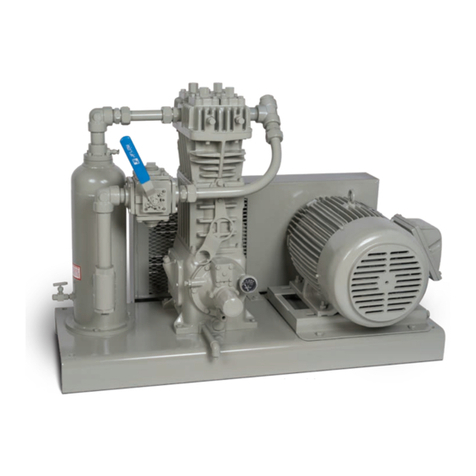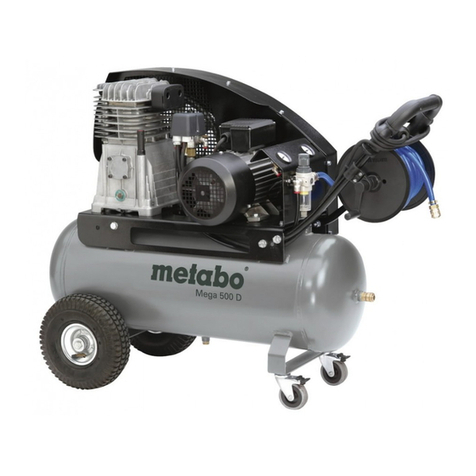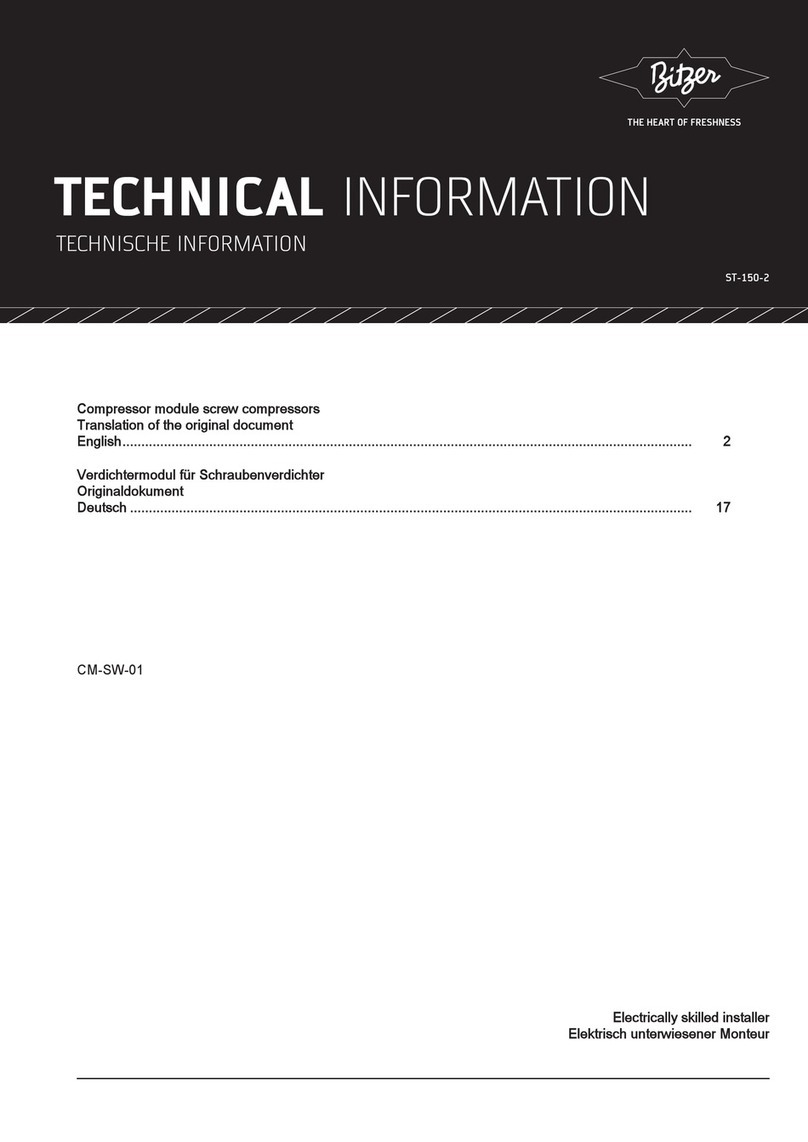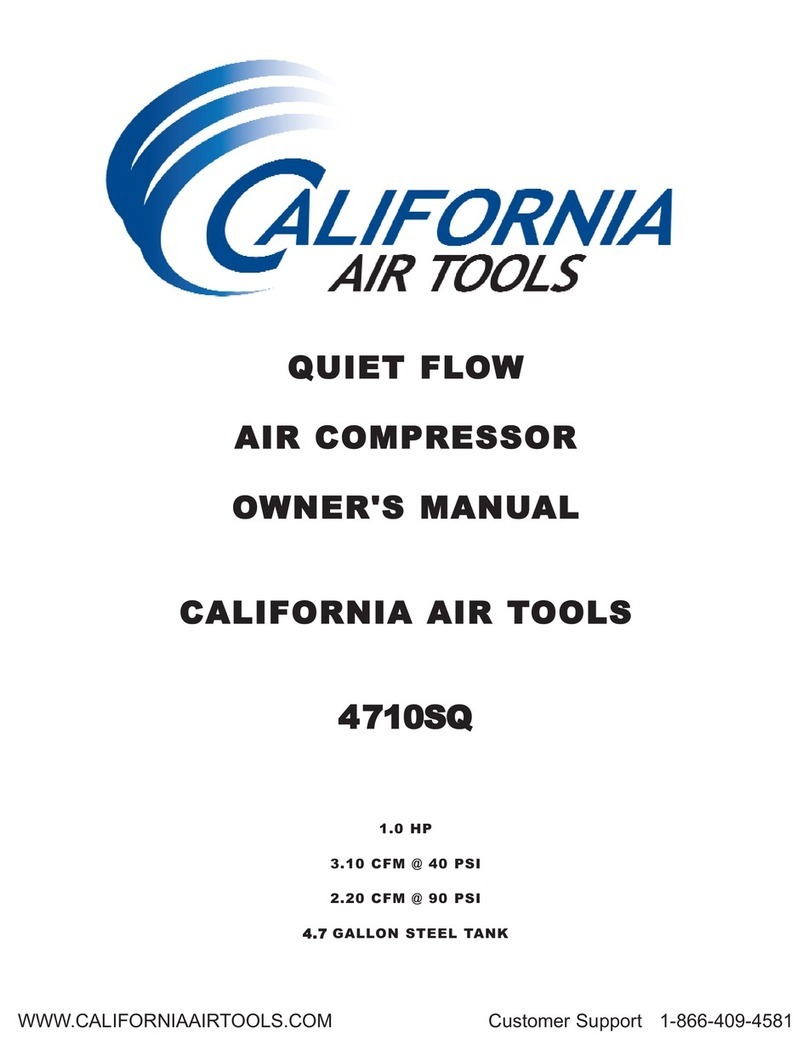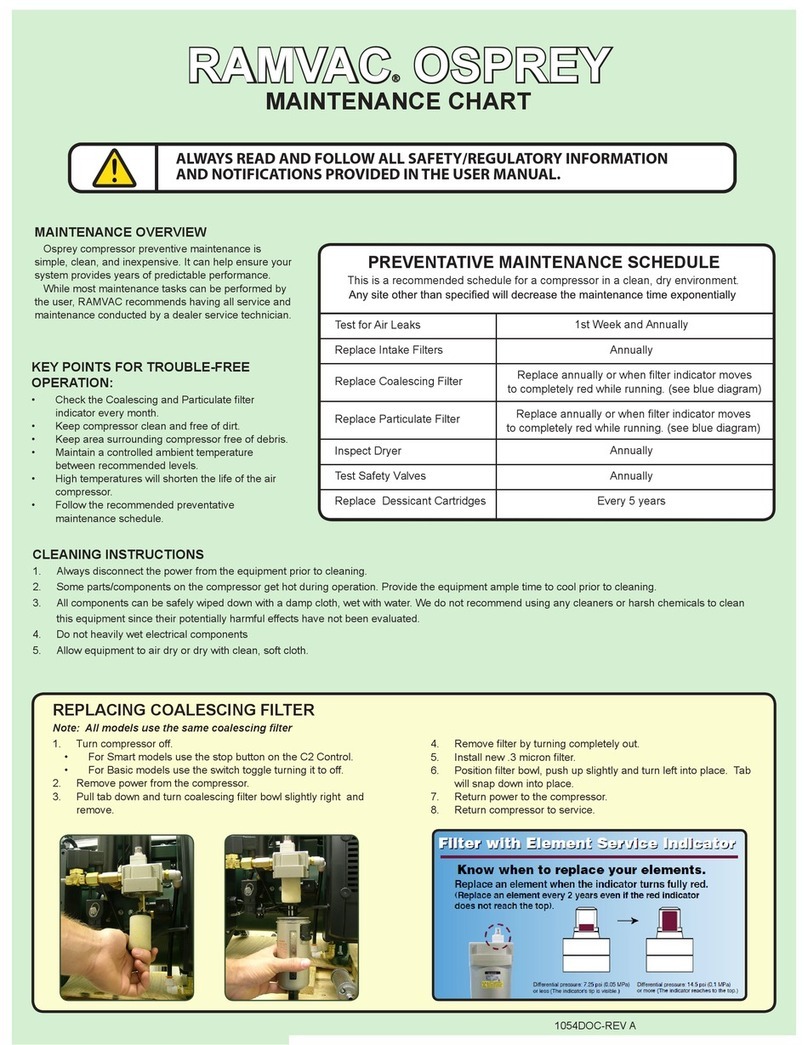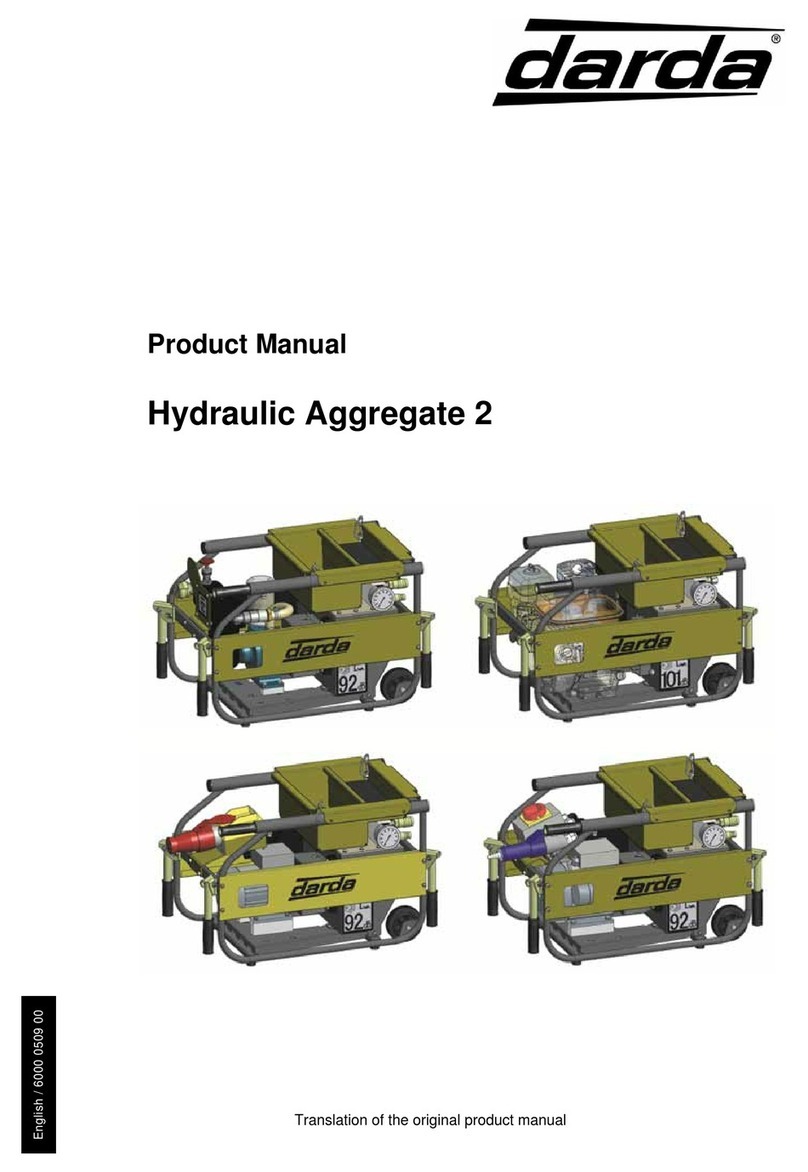Atmos ATMOS C 21 User manual

ATMOS C 21 /
ATMOS C 31
ENT Unit
GA1GB.110200.0
2019-08 Index: 03
Operating Instructions
English
0124

2
5.0 Cleaning and care.............................................22
5.1 General information on cleaning
and disinfection...................................................22
5.1.1 Cleaning the unit surface ....................................22
5.1.2 Cleaning "application parts" ................................22
5.1.3 Secretion canister (without autom. secretion
canisterevacuation),bacteriallterand
suction hose........................................................22
5.1.4 Secretion canister and electrodes (automatic
evacuation of secretion canister) ........................22
5.1.5 Storage canister for ear irrigation system
(option, only ATMOS C 31) .................................22
5.1.6 Medicament sprayers..........................................23
5.1.7 Instrument trays ..................................................23
5.1.8 Irrigation bottles and accessories .......................23
5.1.9 Endoscope quivers .............................................23
5.1.10 Ear irrigation bowl ...............................................23
5.2 Recommended instrument disinfectants.............24
5.3 Recommended surface disinfectants..................25
5.4 Recommended endoscope disinfectants............26
6.0 Maintenance and Service.................................26
6.1 Changingthebacteriallter ................................27
6.2 Changing the rinsing container ...........................27
6.3 Changing the hose box of the hose pump ..........28
6.4 Changing the heating coil of the
mirror quick-heater..............................................29
7.0 Troubleshooting................................................30
7.1 Electrical protection.............................................30
7.2 Power supply ......................................................30
7.3 Mirror heating......................................................30
7.4 Suction system....................................................31
7.5 Light sources.......................................................31
7.6 Compressed-air system......................................32
7.7 Automatic secretion canister evacuation ............32
7.8 Endoscope support.............................................32
7.9 Automatic hose rinsing........................................32
8.0 Consumables, Accessories, Spare Parts ......33
8.1 Consumables......................................................33
8.2 Accessories and spare parts...............................33
9.0 Technical data ...................................................36
10.0 Disposal.............................................................38
11.0 Hygienic plan.....................................................39
12.0 Notes on EMC....................................................41
Content
1.0 Introduction.........................................................3
1.1 Notes on operating instructions ............................3
1.2 Intended use .........................................................4
1.2.1 ATMOS C 21.........................................................4
1.2.2 ATMOS C 31.........................................................4
1.3 Function ................................................................5
1.4 Explanation of symbols.........................................5
2.0 For your safety....................................................6
3.0 Setting up and starting up .................................8
3.1 Front view .............................................................8
3.1.1 Service compartment............................................9
3.2 Setting up proposal.............................................10
3.3 Connection to electrical power line .....................11
3.4 Water supply / Water drainage (option) ..............11
3.5 Independent water supply (only ATMOS C 31)...11
3.6 Starting up...........................................................12
3.6.1 Electrical connection...........................................12
3.6.2 Waste water connection (with optional
automatic secretion canister evacuation)............12
3.6.3 Connection of suction hose.................................12
3.6.4 Connection of the light guide and light source....12
3.6.5 Connection of the compressed air hose (option) 13
3.6.6 Connection of the hose for ear irrigation
(option, only ATMOS C 31) .................................13
3.6.7 Connection of the water system
(option, only ATMOS C 31) .................................13
4.0 Operation...........................................................14
4.1 ATMOS C 21 / C 31 - Basic unit .........................14
4.2 Basic functions....................................................14
4.2.1 Main switch .........................................................14
4.2.2 Maximum loads...................................................14
4.2.3 How to open the covering ...................................14
4.2.4 Suction system....................................................14
4.2.4.1 Emptying the secretion canister..........................15
4.2.4.2 Application with disposable
secretion canister systems..................................15
4.2.5 Light sources.......................................................16
4.2.6 Mirror quick-heater..............................................16
4.3 Options................................................................17
4.3.1 Secretion canister evacuation,
fully-automatic (option)........................................17
4.3.2 Hose rinsing system (option) ..............................17
4.3.3 Compressed-air system (option).........................18
4.3.4 Connection of the ear irrigation system
(option, only ATMOS C 31) .................................20
4.3.5 Tulip-shaped ear irrigation bowl..........................20
4.3.6 Mirror preheater (option).....................................21
4.3.7 Headlamp suspension (option) ...........................21
4.3.8 Endoscope heating (option)................................21
4.3.9 Tongue patches and swab dispenser (option) ....21
4.3.10 Waste bin (option)...............................................21
4.3.11 Holder for standard rail .......................................21

3
1.1 Notes on operating instructions
These operating instructions contain important notes on
how to operate the ATMOS C 21 / C 31 safely, correctly and
eectively.Therefore,theyareintendednotonlyfornew
operating personnel to be instructed in its use, but also for
use as a reference manual. They help to avoid risks, and
also to reduce repair costs and down-times. Furthermore,
reliability and service-life of the equipment will be increased.
For these reasons these operating instructions must
always be kept available near the appliance.
Priortorstusepleaseperusethechapter2.0“Foryour
safety”, in order to be prepared for any possible dangerous
situations.
The basic principles are:
Judicious and careful work provides best protection
against accidents!
Operational safety and readiness for use depend not only on
your capabilities, but also on care and maintenance given
to the ATMOS C 21 / C 31. For this reason regular cleaning
and service work are a must. Major maintenance and repair
work may be carried out only by expert personnel authorised
by ATMOS. In case of repairs you should insist that original
spare parts only are used. You will then have the warranty
that operational safety, readiness for work and the value of
your appliance will be preserved.
These operating instructions are valid for the following devices:
ATMOS C 21 Economy Function Column REF 506.7500.0
ATMOS C 31 Economy Function Column REF 506.7510.0
• Please note that these operation instructions apply for all
ATMOS C 21 / C 31 models and subsequently feature all
options and applications. Therefore, it is possible that this
document may contain descriptions not relevant for your
specicappliancetype.
• The product ATMOS C 21 / C 31 bears CE marking
CE 0124 according to the EC Directive of the council
for medical products 93/42/EEC and meets the basic
requirements of Appendix I of the directive.
• The product ATMOS C 21 / C 31 complies with all
applicable requirements of the directive 2011/65/EC
restricting the use of certain hazardous substances in
electricalandelectronicequipment(“RoHS”).
• The declaration of conformity and our general standard
terms and conditions can be obtained on our website at
www.atmosmed.com.
• The quality management system applied at ATMOS has
beencertiedaccordingtointernationalstandardsEN
ISO 13485.
• ATMOS will supply a service manual containing detailed
circuit descriptions and schematics as well as information
on adjustment and servicing to service organizations
authorized by ATMOS.
• Reprints - also in extracts - only with permission in written
form by ATMOS.
Short cuts / symbols contained in this operating
instructions
• Indicating a list
- Subdivision of a list/activity
The recommended sequence must be followed in each
case!
)Indicating particularly important advice!
ªDescribingtheeectofanactivity.
ATMOS
1.0 Introduction
Phone: + (49) 7653 689-0
Fax:
+ 49 7653 689-190
+ 49 7653 689-493 (Service Centre)
E-mail: [email protected]
Internet: www.atmosmed.de
MedizinTechnik GmbH & Co. KG
Ludwig-Kegel-Str. 16
79853 Lenzkirch
Germany

4
1.2 Intended use
1.2.1 ATMOS C 21
Name: ATMOS C 21
Main functions:
• Suction
• Compressed air system for medication spraying and the
Politzer manoeuvre
• Ear irrigation
• Electric power supply for LED light handles and LED
headlight
• Light sources
• Storage and heating of endoscopes
• Mirror quick heater
• Instrument deposit and heating
Medical indications / application:
Standard ENT examination and/or therapy
Specication of the main function:
• Suction at 40 l/min / -76 kPa
• Alternatively suction at 55 l/min / -98 kPa
• Compressed air for medication spraying, max. 2 bar
• Compressed air for the Politzer manoeuvre, regulated
• Ear irrigation with 37 °C ± 1 °C, max. 500 ml/min
• Electric power supply for LED, 700 mA
• Light source LED for light guide
Application organ:
Mouth to pharynx, auditory canal to the ear drum and the
nasal cavities
Application time:
• ENT unit: Short term use (up to 30 days)
• Suction / Compressed air / ear rinsing / light source:
Temporary application on the patient (less than 60
minutes)
Application site:
Application sites are clinics and practices for ENT doctors
and phoniatrists. The examination and/or therapy with
the ENT unit may only be executed by medically trained
persons.
Contraindications:
May not be used for irrigation of the paranasal sinuses. The
ear irrigation should not be applied to an infected auditory
canal or a perforated eardrum.
The product is: active
Sterility:
The ENT unit is no sterile product.
Single-use product / reprocessing:
The ENT unit is intended for multiple use. The device and
parts of the accessories are reusable. For information on
reprocessing, cleaning and disinfection, please see the
operating instructions.
1.2.2 ATMOS C 31
Name: ATMOS C 31
Main functions:
• Suction
• Compressed air system for medication spraying and the
Politzer manoeuvre
• Ear irrigation
• Electric power supply for LED light handles and LED
headlight
• Light sources
• Storage and heating of endoscopes
• Mirror quick heater
• Instrument deposit and heating
Medical indications / application:
Standard ENT examination and/or therapy
Specication of the main function:
• Suction at 40 l/min / -76 kPa
• Alternatively suction at 55 l/min / -98 kPa
• Compressed air for medication spraying, max. 2 bar
• Compressed air for the Politzer manoeuvre, regulated
• Ear irrigation with 37 °C ± 1 °C, max. 500 ml/min
• Electric power supply for LED, 700 mA
• Light source LED for light guide
Application organ:
Mouth to pharynx, auditory canal to the ear drum and the
nasal cavities
Application time:
• ENT unit: Short term use (up to 30 days)
• Suction / Compressed air / ear rinsing / light source:
Temporary application on the patient (less than 60
minutes)
Application site:
Application sites are clinics and practices for ENT doctors
and phoniatrists. The examination and/or therapy with
the ENT unit may only be executed by medically trained
persons.
Contraindications:
May not be used for irrigation of the paranasal sinuses. The
ear irrigation should not be applied to an infected auditory
canal or a perforated eardrum.
The product is: active
Sterility:
The ENT unit is no sterile product.
Single-use product / reprocessing:
The ENT unit is intended for multiple use. The device and
parts of the accessories are reusable. For information on
reprocessing, cleaning and disinfection, please see the
operating instructions.
1.0 Introduction

5
1.3 Function
• The ATMOS C 21 / C 31 is operated by activating the
main switch ( 1,g.1,page8).
• The exact mode of function of the standard equipment
and optional functions is described in detail in chapters
4.2 and 4.3.
1.4 Explanation of symbols
ATMOS C 21 / C 31
On/Oswitch
ION (power) as to IEC 417/5007 and DIN
30600/16
OOFF(power) as to IEC 417/5007 and DIN
30600/16
Follow operating instructions (blue)
Warm water system
Suction system
Compressed-air system
Cleaningwiththeowmethod
(hose rinsing)
Light guide connection
No function
Transfer of heat, in general; mirror heater
Short-time operation
Foot switch
Dangerous voltage as to IEC 417/5036, DIN
30600/131
Protective earth (ground) as to IEC 417/5019,
DIN 30600/1545
Fuse as to IEC 417/5016, DIN 30600/0186
Type B equipment as to IEC 417/5333
Type BF equipment as to IEC 417/5333
~Alternating current
Do not lean against it!
060.0628.0
Danger of tilting for units with
a microscope!
Screw the unit into the ground
or position it near a wall.
Only ATMOS C 31
Water temperature for ear irrigation is too high
Correct water temperature for ear irrigation
Water temperature for ear irrigation is too low
2.0 Introduction

6
2.0 For your safety
• The ATMOS C 21 / C 31 is produced according to IEC
601 / EN 60601 and listed in the following classes:
- VDE Class of protection 1
- Class IIa (EEC 93/42).
• The unit may be connected only to a socket outlet with
earthing contact installed according to the rules of the
trade.
• The unit should not be positioned directly next to a wall,
because of the ventilation openings on the rear side!
• When a microscope is mounted: Screw the unit into the
ground or position it near a wall. If the microscope is in an
unfavourable position it could tilt the unit backwards.
• The ATMOS C 31 requires clean water (drinking-water
quality) for the operation. In case the clean water cannot
beprovidedbythewatersupply,apre-lterhastobe
installed.Therelevantcountryspecicregulationsforthe
installation have to be considered.
• Caution! Mirror and endoscope heaters may generate
temperatures above 40° C!
• Attention with the cold-light source!
Because of the high energy of the light there is a large
amount of heat emission at the point of the optical
system. Avoid too small a distance between the tissue
andtheeldoflightemissionofthelightguiderespective
of the endoscope, as this may cause coagulation of the
patient's tissue. When using the endoscope avoid the
direct contact between area of light emission and the
tissue.
Attention, Fire Hazard!
Never place the area of light emission from the light
guide or from the endoscope onto heat-absorbing
surfaces (dark pieces of cloth, etc.), because this will
cause unacceptable high heating or even ignition of the
material.Switchthelightowhenyoudonotrequirethe
light over a prolonged period of time.
• Care is to be paid in respect to light sources when
working with endoscopes. The intensity of the light is very
high. Do not look directly into the light outlets! In case
of possible light failure remove the endoscope from the
working area.
• Always make sure that you do not blind patients with the
light source! Watch out that patients do not look directly
into the light source! Never look directly into the light
source!
> Damage to the eyes due to the strong glare.
• Exclusively connect ATMOS HL 21 LED and ATMOS LS
21 LED to the connections for ATMOS HL 21 LED and
ATMOS LS 21 LED. Unsuitable application parts may
result in an electric shock or damage. Cardiac arrhythmia
and even death are possible.
• The ATMOS C 21 / 31 may be used in supervised
operationbyqualiedpersonnelonlywhichhasbeen
authorised by ATMOS and which has been trained for
operating the appliance (IEC 601-1/EN 60601-1).
• The mains voltage indicated on the type plate must
correspond to the values of the supply network.
• Make sure prior to every application of the equipment that
it is technically safe and in proper condition. Damaged
leads and hoses must be replaced immediately!
• Display instruments and valves must be checked for
correct function in regular intervals!
• Inspection of compressed air and vacuum display by
service technician every 2 years!
• Correctcongurationinassemblyofcountry-specic
connections:
- green/yellow: protective conductor (PE)
- blue: neutral conductor (N)
- black or brown: phase (L)
• This product is not re-sterilizable. Repeated reuse of
components which are marked with a 2is forbidden.
In case of repeated reuse these components lose their
function and there is a high infection risk.
• The control panel must be well visible to and in reach of
the operator.
• Do not place used contaminated instruments on the ENT
unit!
• Theambientconditionsspeciedinthe"Technicaldata"
(chapter 9.0) must be strictly observed!
• The suction system of the ATMOS C 21 / C 31 is only
tobeusedforthesuctionofuidsinthemedicaleld.
Neverremoveexplosive,inammableorcorrosivegases
oruids.
• Switchomainswitchafternishingworkinpracticeand
close water supply, if present.
• The ATMOS C 21 / C 31 may be operated only in rooms
used for medical purposes, but not in areas subject to
explosion hazards and in oxygen rich environments.
• The ATMOS C 21 / C 31 fully complies with the
electromagnetic immunity requirements of standard IEC
601-1-2 / EN 60601-1-2 "Electromagnetic compatibility -
Medical Electrical Equipment".

7
• The ATMOS C 21 / C 31 may not be operated with units
not complying with the requirements of standard EN
60601-1 "Medical Electrical Equipment" and EN 60601-
1-2 "Electromagnetic compatibility (Medical Electrical
Equipment)".
• The warranty will be rendered invalid in case of
damages caused due to the utilization of accessories or
consumables which are not approved by ATMOS for use
with this unit.
• ATMOS is not liable for personal injury and damage to
property if
- no original ATMOS parts are being used,
- the advice for use in these operating instructions is
not being observed,
- assembly, new settings, alterations, extensions
and repairs have been carried out by personnel not
authorised by ATMOS.
• Please pay also attention to the safety information in
following chapters.
• Please note:
A medical insulating transformer with earth leakage
monitor or any similar safety system acc. to EN 60 601-1
is required, if several devices are connected over one
common power supply. The transformer must correspond
to the power consumption of all the devices to be
connected.
• When connecting several devices on one grounding
receptacle, the allowed strain and leakage current have
to be observed!
• Never leave the patient unattended at the treatment unit.
• Itisnotallowedtouseammablesubstanceswiththe
device.
2.0 For your safety

8
3.1 Front view
Drawer resp. deposit for used instruments (optional)
Drawer resp. waste bin (option)
Connections for light guide
Vacuum control
Door for service compartment
Compressed-air control (option)
Suction
Compressed-air handle (option)
Handle ear irrigation (option, only ATMOS C 31)
Irrigation canister for hose rinsing (option)
Fig. 1. ATMOS C 21 / C 31 Front view
Main switch
Sprayer (option)
Laryngoscope holder
Surface for medicament bottles etc.
Ear irrigation (option, only ATMOS ®C 21)
Headlamp suspension
Cover for upper instrument deposit
Instrument surface
Free surface
3.0 Setting up and starting up
1
19
18
17
16
2 3 4 5 66 7
8
9
10
1112131415
1
2
3
4
5
6
7
8
9
10
11
12
13
14
15
16
17
18
19

9
3.1.1 Service compartment
Fig. 2. ATMOS C 21 / C 31 Service compartment
Hose for automatic secretion canister evacuation (optional)
Connecting nipple with hose to the vacuum pump
Secretion hose
Connecting electrodes for automatic secretion canister evacuation (optional)
Attachment for secretion hose
Secretion canister
Lid(variantwithbacteriallterplate)
3.0 Setting up and starting up
1 2 3 4 5
6
7
1
2
3
4
5
6
7

10
3.2 Setting up proposal
At option 2 - where the instrument
deposit is slidable (backwards) - an
extra 250 mm distance to the wall is
required.
560 mm + 250 mm = 810 mm
22.5" + 9.84" = 31.84"
3.0 Setting up and starting up

11
Fig. 4.
Inlet connector for non-heating apparatus
Connection for waste water hose
Fig. 3.
Socket outlets with earthing contact
Water drainage G3/4" external thread (optional)
Water supply with water tap G 3/4" external thread
(optional)
3.3 Connection to electrical power line
• According to the directions of VDE 0107 and VDE
0100, medically used rooms have to be equipped with
a leakage current protective circuit (FI protective circuit)
with a nominal leakage current of < 0.03 A. Installation
must correspond with VDE 0107.
• The ATMOS C 21 / C 31 is connected to a earthing
contact socket which is to be mounted near the unit
(max. 3 m, preferably on the left side, next to the function
column)(seeg.3).
• The current consumption of the ATMOS C 21 / C 31 is
maximum 5 A .
• For the connection of further electrical devices, please
allow for extra plugs (installation of an electrically
operated patient chair).
3.4 Water supply / Water drainage
(option)
Water supply:
Prerequisites:
• There must be existing water pipes with a G 1/2" (internal
thread). For connecting a corresponding water or ball
valve with a G 3/8" hose connection.
• This (water tap) ball valve must be installed in such a way
thatitcanbeturnedowithoutanyproblem.
• The water which is provided by the household connection
must at least meet the WHO guidelines or the country-
specicguidelinesfordrinkingwater.
• Rinse water supply line in order to remove any
contamination from the system.
• When clean water is available, connect delivery hose to
water tap mentioned above.
• Required pressure in domestic water system: > 2 bar, but
< 5 bar.
• Therearecountry-specicregulationsfortheinstallation
to be considered when the unit is connected to the public
water supply.
• Thereisnospecialcalcicationsafetydeviceintegrated
in the water system.
Such a system is to be connected when the respective
drinking water is of hardness grade 3 (14 - 21°d resp. 2.5
- 3.8 mol/m³ = hard water) but especially with hardness
grade 4 (from 21°d resp. from 3.8 mol/m³ = very hard
water). You may receive information on the hardness
gradeofyourwaterfromthewatersupplyoce.
Water drainage (option):
Prerequisites:
• PermanentlyinstalledconnectionttingwithG3/4"
external thread.
• To adapt the 3/4” draining hose to standard HT 40
a connection adapter 510.2130.0 can be ordered
(510.2129.0 for HT 50).
• Connect waste water hose with unit ( 2,g.4)andthe
G3/4"connectiontting(insertpertainingseals!).
An anti-syphon trap is not required!
3.5 Independent water supply (only
ATMOS C 31)
If the system is not connected to a water supply, we
recommendyoutollthestoragecanisterfortheear
irrigation system with 2.0 litres of tap water or hygienically
safe drinking water.
For information on the maintenance and cleaning of the
water supply, see chapter 5.1.5 in the operating instructions.
3.0 Setting up and starting up
1
2
3
21
1
2

12
Fig. 5. Connections light package 2-channels version 1
1, 2Connections for light guide
3, 4Connections for ATMOS HL 21 LED and
ATMOS LS 21 LED
1 2 3 4
3.0 Setting up and starting up
3.6 Starting up
3.6.1 Connection to electrical power line
• Join the inlet connector for non-heating apparatus ( 1,
g.4)withtheearthsocketoutletusingthepowercable
supplied.
3.6.2 Waste water connection (with optional
automatic secretion canister evacuation)
• Connect the waste water connector ( 2,g.4)tothe
water drain ( 2,g.3).
3.6.3 Connection of suction hose
• Thread the suction hose through the hole on the side into
the service compartment and insert it onto the secretion
hose connector ( 5,g.2).
)The transport locking screws on the unit's baseplate must
beremovedbyskilledstapriortostartingup!Todothis,
the rear panel must be opened and the two front screws
must be unscrewed. The pump unit is removed from the
rear locking device by pulling it forwards.
3.6.4 Connection of the light guide and light
source
Theunithasdierentconnectionsdependingonthe
conguration:
Light package LED economy:
• 2 connections for ATMOS HL 21 LED and ATMOS LS 21
LED
Light package 2-channel with 2 or 4 channels:
Version1(g.5):
• 2 connections for light guide
• 2 connections for ATMOS HL 21 LED and ATMOS LS 21
LED
Version 2:
• 2 or 4 connections for light guide
Version 3:
• 2 or 4 connections for ATMOS HL 21 LED and ATMOS
LS 21 LED
Exclusively connect ATMOS HL 21 LED and ATMOS LS 21
LED to the connections for ATMOS HL 21 LED and ATMOS
LS 21 LED. Unsuitable application parts may result in an
electric shock or damage. Cardiac arrhythmia and even
death are possible.
• Connect the light guide or light source.
)If you require several adapter sleeves (e.g. Olympus,
Pentax, Wolf, etc.), they may be interchanged as
necessary (see chapter 8.2).
)Sothatthebre-opticcablesdonotrestontheoor,they
may be threaded through behind the handle support.
!

13
Fig. 6.
CPC coupling
3.6.5 Connection of the compressed air hose
(option)
Connection of the function hose for compressed air at the
side of the column.
• Compressed-air hose is connected by means of plug
connections; make sure that the plug attachment is
engaged. The hose is disconnected by pressing the
release slide ( 1,g.6)attheplugconnectorandby
pulling out the plug attachment.
)Push the handles into the handle support as indicated by
the symbols.
The photoelectric barriers will operate the wrong
units if the handles are transposed!
3.0 Setting up and starting up
Fig. 7. Connecting the hose for ear irrigation
Connection for the ear irrigation hose
Connection for the compressed-air hose
3.6.6 Connection of the hose for ear irrigation
(option, only ATMOS C 31)
The hose for the warm water system is screwed on the CPC
coupling.
)Dierentsocketnipples;swappingofthehosesisnot
possible!
3.6.7 Connection of the water system (option,
only ATMOS C 31)
Connect the aqua stop valve to the water tap (house
connection). Open the water tap. If the main switch is
activated and a water consuming device (basin rinsing or
hose rinsing system) is used, the water supply is opened by
an automatic opening of the magnetic valve in the aqua stop
system.
ªThus, there is no pressure inside the water supply
hose if no water consuming device is activated.
1
1 2
1
1
2

14
4.1 ATMOS C 21 / C 31 - Basic unit
TheENTunitATMOSC21/C31oersoptimuminstrument
handling whilst at the same time providing an optimum
arrangement of all functions that an ENT specialist requires
for his daily work in the practice.
The instrument deposit area:
At the top of the functional column there is an area designed
to take medicine bottles ( 4, Fig. 1, page 8), hence the
instrument deposit area is also very suitable instruments.
There is also the facility for protective storage of less
frequently used instruments and consumables in the
drawers ( 10 and 11,g.1).
)Most of the unit's surfaces are coated with a special
texturedlacquerthatfullstherequirementsfor
workplace hygiene. However, as the lacquer is not
resistant to all medicines and disinfectants it is imperative
to wipe up splashes immediately.
4.2 Basic functions
4.2.1 Main switch
• The ATMOS C 21 / C 31 is switched ON and OFF by
means of the main switch ( 1,g.1,page8).
4.2.2 Maximum loads
• Persons must not lean on the ATMOS C 21 / C 31
(danger of tilting).
• Maximum load of the instrument surface: 15 kg.
• Maximum load of the writing and working surface: 10 kg.
• Maximum load of the second deposit surface (optional):
7.5 kg.
4.2.3 How to open the covering
• Open the unit covering up to the stop.
4.2.4 Suction system
The hose attachment must be exchanged after each patient.
)Prior to each application, proper function of the display
instruments and control valves must be checked!
• Purpose of the suction system:
- Suctionofuidsandsecretions;collectingthe
secretion in the secretion canister.
• Automatic activation of the suction mode by taking out
the suction attachment.
• Control of the suction performance via the rotary knob for
vacuum control ( 2,g.9).
!
Fig. 8. Maximum load
max.
15 kg
4.0 Operation

15
• Indication of set vacuum at vacuum gauge ( 3,g.9)
(keep suction attachment closed by hand).
• Secretion is collected in 1.25 l canister with mechanical
overowsafetyandwater-repellentbacteriallter.
ªPrevents ingress of secretion into the pump.
)Secretion canister to be emptied when half full at the
latest, see chapter 4.2.4.1!
)The suction system may be operated only with inserted
bacteriallter.Incasethelterisblockedithastobe
exchanged (see chapter 6.1) !
Forhygienicreasons,thebacterialltershouldbe
exchanged daily.
)The suction hose must never come into direct contact
with the application site. Always use a suction catheter,
suction tip, or medical suction set!
)Change the suction catheter after every patient and
clean the suction hose, e.g. with the aid of the optional
hoserinsingsystem(aspiraterinsinguidordisinfectant
solution)!
• All commercially available models of suction cannulae
(Adson, Walter, Frazier, Fergusson, Plester, Yankauer,
Torrington) may be attached to the silicone attachment.
4.2.4.1 Emptying the secretion canister
• Detach all hose connections carefully on the lid system
and take secretion canister out carefully to prevent spills
and contamination of the area. Dispose of secretions
properly.
• Griplidsystemrmly,openlidoflterhousingbyturning
inanti-clockwisedirection.Withbacteriallterplateor
integratedbacteriallter:Removelteranddisposeitof.
• Rinse all parts thoroughly under running water. A
detergent or cleaning agent may also be used if required.
• Aftercleaninganewltermustbeinserted(withbacterial
lterplate:smoothsidedown).Seechapter6.1.
See also suction accessories (chapter 8.2).
4.2.4.2 Application with disposable secretion
canister systems
Assemble the disposable canister system:
Insert the disposable bag into the canister. Seal properly on
all sides. Check again for tightness, otherwise there will be
no build up of vacuum. Connect the vacuum hose.
)Please observe the operating instructions of the
disposable secretion canister system.
)Please observe the valid hygiene and waste disposal
measures.
)Only the recommended ATMOS disposable secretion
canisterswithintegratedltermaybeused!
Fig. 9. Suction
Suction attachment
ON switch
Vacuum gauge
Vacuum control
Fig. 10.
Secretion hose
Bacteriallterplate
4.0 Operation
Fig. 11 Disposable secretion canister systems
1 2 3 4
1
2
3
4
1
2
1
2

16
4.2.5 Light sources
)Do not look directly into the light outlets.
)Because of the high energy of the light there is a large
amount of heat emission at the point of the optical
system.
)Switchthelightowhenyoudonotrequirethelightover
a prolonged period of time.
Light package LED economy:
• Select the light source with the switch 1(g.12).
Light package 2-channel with 2 or 4 channels:
Switch on
• Remove the light guide from the holder ( 4,g13)orthe
headlight from the headlamp suspension ( 3,g13).
)You can manually switch on the light source with the
buttons 1 to 4 ( 5,g.13).
Intensity control
• Switch on the light source.
• Press the button 1(g.13),toreducethebrightnessor
press 2, to increase the brightness.
)Whenthedeviceisswitchedothelastadjustmentwill
be kept.
Fig. 12. Light package LED economy:
Switch for selecting the light source
Fig. 13. Light package 2-channel with 2 or 4 channels:
Reduce brightness
Increase brightness
Headlamp suspension
Holder for the light guide
Selection of the light channel
4.2.6 Mirror quick-heater
• Switch on the mirror quick-heater with key switch ( 2,g.
14). The mirror quick-heater heats up for 10 seconds and
thenswitchesoautomatically.
• Supply voltage of the heating coils: 6 V / 15 A.
• Hold the mirror to be heated over the burning heating coil
(1,g.14)locatedbeneaththesafetycover.
)Prior to use of the mirror, always check its temperature
(with hand etc.)!
)Automatic switching to avoid overheating!
)Safety cover, sleeve and heating element might be very
hot. Do not touch directly after heating-up (hot)!
• Changing the heating coil, see chapter 6.4.
Fig. 14. Mirror quick heater
Heating coil
Push-button
4.0 Operation
1
1
4
3
2
5
1 2
1
1
2
3
4
5
1
2

17
4.3.1 Secretion canister evacuation, fully-
automatic (option)
• Purpose:
- Prevents interruption of work in practice.
- Secretion is not held in canister over a longer period
of time.
- Preventscontactofstawithsecretion.
• Activated automatically when:
- Reachingtheupperllinglimit(electrodes).
- Returning suction attachment to holder.
)The tube cassette of the tube pump is a wear part and
must be replaced at regular intervals (see chapter 6.3)!
)Pay attention to cleaning described in chapter 5.0!
4.3 Options
Fig. 15. Service compartment
Hose for automatic secretion canister evacuation
(optional)
Connecting nipple with hose to the vacuum pump
Secretion hose
Connecting electrodes for automatic secretion canister
evacuation (optional)
Attachment for secretion hose
Secretion canister
4.0 Operation
4.3.2 Hose rinsing system (option)
After use, the suction system must be rinsed by means of
the hose rinsing system.
• Insert the silicone suction attachment onto the white
attachment of the hose rinsing (front of the unit) and
clean the hose system by rinsing the hose for a few
seconds.
ªThis procedure will prevent the hoses and suction
cannula from clogging up.
Thecanisterfortherinsinguidofthehoserinsingis
located in the service compartment at the front of the unit.
For optimum cleaning, add the ATMOS special cleanser (Art.
No. 080.0006.0) to the rinsing liquid. Optionally the canister
canbeautomaticallylledupwithfreshwater.Watersupply
is then controlled by a level switch. A safety switch beside
thecanisterinthecanistersupportpreventsoverowing,in
casethecanisteroverowsorisnotavailable.
)The suction attachment of the hose rinsing system may
be contaminated. Therefore, it must be cleaned and
disinfected daily!
Fig. 16.
Float switch
Pipe for the hose rinsing system
Hose rinsing canister
1 2 3 4 5
6
1
2
3
4
5
6
1
2
3
1
2
3

18
4.3.3 Compressed-air system (option)
)Prior to each application, proper function of the display
instruments and control valves must be checked!
Purpose of compressed-air system:
a) Medicaments can be applied to the nasopharynx:
• The pump for the compressed-air system switches on
after the compressed-air handle has been removed from
its holder.
• Handle is mounted on a sprayer. The top of the
compressed-air handle locks in place in the ring of the
sprayer bottle.
• Available sprayers:
- with straight spraying tube for normal liquid
medicaments
- with twin tube and adjustable angular jet for oily
medicaments.
)If a sprayer is used with medication the instructions of the
medication manufacturers have to be observed.
)Do not use the sprayer for the storage of medication!
)Caution to be paid to avoid injury when introducing
sprayer jet!
Please note, in case the ventilation opening is blocked or
thesprayerheadisimmersedinuids(e.g.blood,secretion,
etc.)anegativepressurecouldoccurandtheuidcould
owbackintothebottle.
Inthiscasethemedicinesprayer,sprayerhead,exible
nozzle as well as the hose piece for the medicine sprayer
must be reprocessed as described in chapter 5.0 cleaning.
• Pull the release lever.
ªThe medicament sprayer is supplied with air and the
medicament in the sprayer bottle is atomized.
• The amount of compressed air is adjusted with
the control knob ( 3,g17)inconjunctionwiththe
compressed air gauge ( 2,g17).
• After use, the medicament sprayer is again inserted in its
holder, the bar is pressed, the handle is removed from
the sprayer and again inserted in its support.
ªCompressed-airsystemisagainswitchedo.
)For hygienic reasons, the spraying tubes are to be
exchanged following each application or with each
patient.
Fig. 17. Compressed-air system
Sprayer suspension
Compressed-air display
Compressed-air control
Support for automatic photoelectric barrier control
Compressed-air handle
4.0 Operation
1
2345
1
2
3
4
5

19
Fig. 18. Compressed-air handle with Politzer adapter
Politzer olive
Adapter for Politzer olive
Compressed-air handle
Fig. 19. Removal of the irrigation bottle
Fig. 20. Compressed-air handle
Release button
Air valve
Adjusting lever
b) Politzer manoeuvres with Politzer olives or
Eustachian catheter can be carried out.
• The pump for the compressed-air system switches on
after the compressed-air handle has been removed from
its holder.
• The adapter ( 2,g.18)suppliedforthispurposeis
locked into the compressed-air handle.
• Politzer olive ( 1,g.18)isinsertedintheadapter.
)ThepressurefortheinsuationoftheEustachiantube
can be controlled by means of the manometer and the
compressed-airregulator.Selectaninsuationpressure
adapted to the condition of the tympanic membrane. If
the tympanic membranes are already pre-damaged even
low pressure values might lead to injuries ! Maximum
pressure must not exceed 0.2 bar!
• Activating, adjusting and regulating the compressed
airandswitchingothecompressed-airsystemas
described above.
• Scope of delivery:
- Compressed-air system with pump, regulating
valve, manometer, handle and handle holder with
photoelectric barrier control;
- 3 medicament sprayers (2 single tube, 1 twin tube
sprayers for viscous medicaments);
- Politzer adapter;
- Politzer olive (for children);
- Politzer olive (universal size).
• Accessories, see chapter 8.2.
c) For ear irrigation
Prior to each ear irrigation perform a visual check to see if
the patient's eardrum is perforated. Do not irrigate the ear if
itisperforatedorinamed!Otherwisetheinammationcan
spread.
Preparation
• Fill both irrigation bottles with microbiologically safe
drinking water. Ideally the drinking water is at room
temperature.
• Position the reprocessed irrigation lid with irrigation hose.
• Attach the splash protection and hose tip.
• Place both irrigation bottles in the heated quiver for
warming.
Irrigate ear
• Attach the compressed air handle to an irrigation bottle.
• Remove the compressed air handle with the irrigation
bottle from the heated quiver.
• Check the water temperature with the back of your hand.
Cold water causes dizziness for patients.
• Position the ear irrigation nozzle.
• Close the air valve with your thumb.
• Press the release lever to irrigate the ear.
Conclude
• Release the lever.
• Remove your thumb from the air valve.
• Place the irrigation bottle in the heated quiver.
• Press the release button and remove the compressed air
handle from the irrigation bottle.
• Hang the compressed air handle in the holder.
!
1
2
3
1
2
3
4.0 Operation
1
2
3
1
2
3

20
4.0 Operation
4.3.5 Tulip-shaped ear rinsing bowl
• Purpose: To collect the water during ear irrigation.
• The tulip-shaped bowl is attached to the suction
attachment of the suction system.
• We provide a special support for the ear irrigation bowl.,
as an accessory.
Fig. 24. Ear irrigation bowl
4.3.4 Ear irrigation system (option, only ATMOS
C 31)
• The ear irrigation system is supplied with water from a
heated storage canister (37°C) 4.5 l ( 3,g.22).This
canistercaneasilybelled,cleanedordisinfected.The
pump only switches on automatically when required.
Waterpressureandowquantitymayberegulatedwith
the release lever on the irrigation handle. With the switch
1,g23,theearirrigationsystemcanbeswitchedon
ando.
)DonotswitchontheENTunituntilwaterhasbeenlled
in the storage canister of the ear irrigation system.
• Fill the storage canister,e.g. using a measuring cup
(000.0583.0), with microbiologically safe drinking water
(min. 2 l, max. 4,5 l, drinking water quality) and close the
lid.
)The water must not be contaminated and its temperature
must not exceed 37°C as it cannot be cooled down. If
thereisnodrinkingwateravailable,youmayalsoll
the storage canister with an isotonic saline solution.
Alternatively, you may achieve drinking water quality by
lteringorboilingthewaterresp.byaddingdisinfectants.
)This system may not be used if the auditory canal is
injured as there could be a risk of infection if the irrigation
liquid is contaminated.
• The temperature display indicates the water temperature.
It takes approx. 15 min. until 2 litres of cold tap water
are heated up to 37°C. Observe the temperature display
and check water temperature prior to every application.
As soon as the middle lamp illuminates the water has
reached the desired temperature.
• Takethewaterhandlefromthesupportandsprayo
the water until it is free of air bubbles and the level of the
pump noise becomes less (repeat this procedure every
time the pump noise gets louder, e.g. after long periods
during which it has not been used or after the water level
has dropped below the suction limit).
• Change the jet connection daily. Only use disinfected jet
connections, in order to prevent spreading germs. Use
the hose tip, REF 502.0844.0, to avoid damages to the
eardrum. Exchange the hose tip after every patient.
Frontfolie ATMOS C 31
Bedienteil LED 4
060.0700.0
060.0411.0
1:1
03.11.16 O.Eirich
Blatt
(sheet)
1
Bl.1/1
(index)
Zust. (revision)
Änderung Datum
(date) Name
(name)
Maßstab (scale) Konstr. Nr.
Gepr.
Bearb.
Name
Erstellt
Datum
Ers.f. : Ers.d. :
Benennung (description)
Zeichnungs /
Artikel-Nr.
(part no.)
Alle Maße in mm/
all dimensions in mm
Allgemeintoleranzen /
General tolerances
DIN ISO 2768 - mK
79853 Lenzkirch / Germany
MedizinTechnik
ATMOS Medizin Technik GmbH & Co. KG
Ludwig - Kegel - Str. 16
Tel: +49 7653 689 -0
Fax: +49 7653 689 -190
www.atmosmed.de
Schutzvermerk (Copyright notice) DIN ISO16016
A3
37°C
1 2 34
Grundfarbe: RAL 9002 Grauweiß
Präge-, Tastenflächen, Symbole: RAL 7043 Verkehrsgrau B
Abgesetzte Fläche: RAL 7042 Verkehrsgrau A
Logo und Symbol Ø9 mm „Anleitung beachten“: RAL 5005 Signalblau
Transparent Ø3,0 und Ø4,5 mm, und 7,0x25,0 mm
Tasten und Fläche geprägt, Tasten Ø13 mm
Fig. 21.
Water temperature display
Fig. 22.
Irrigation handle
Connection for irrigation handle
Storage canister for ear irrigation 37°C
Irrigation hose
Fig. 23.
1
1
1
2
3
4
1
2
3
4
1
This manual suits for next models
1
Table of contents
Other Atmos Air Compressor manuals
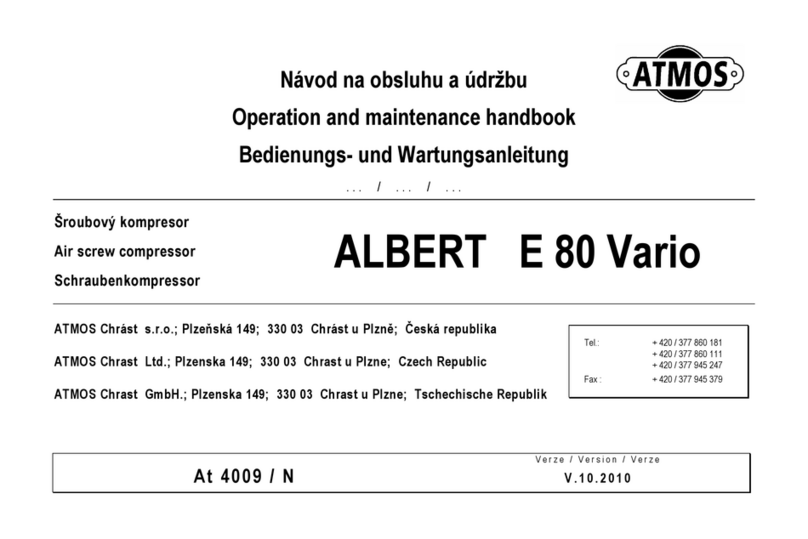
Atmos
Atmos ALBERT E 80 Vario Manual

Atmos
Atmos PDP 90 Manual
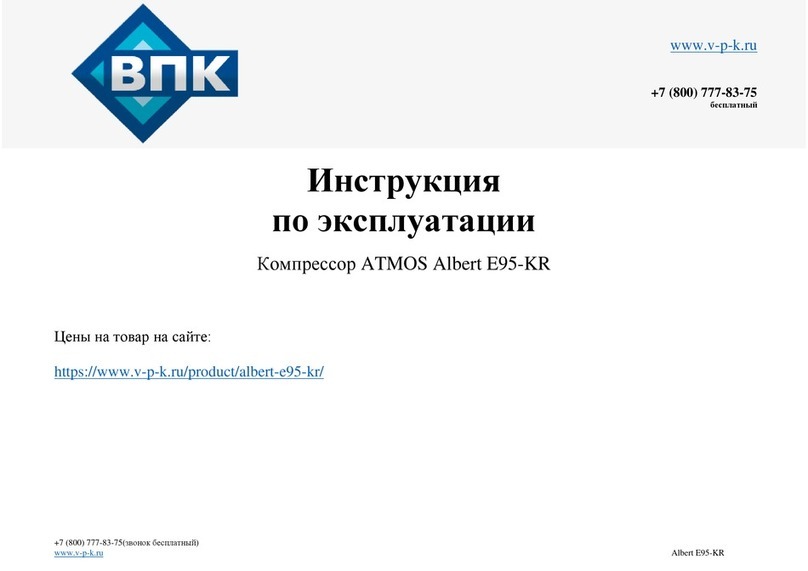
Atmos
Atmos Albert E95-KR User manual
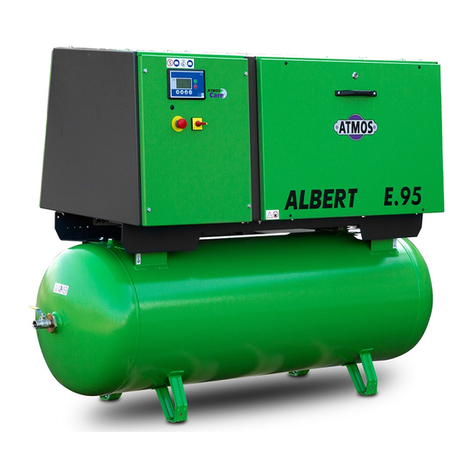
Atmos
Atmos Albert E95-10-KR User manual
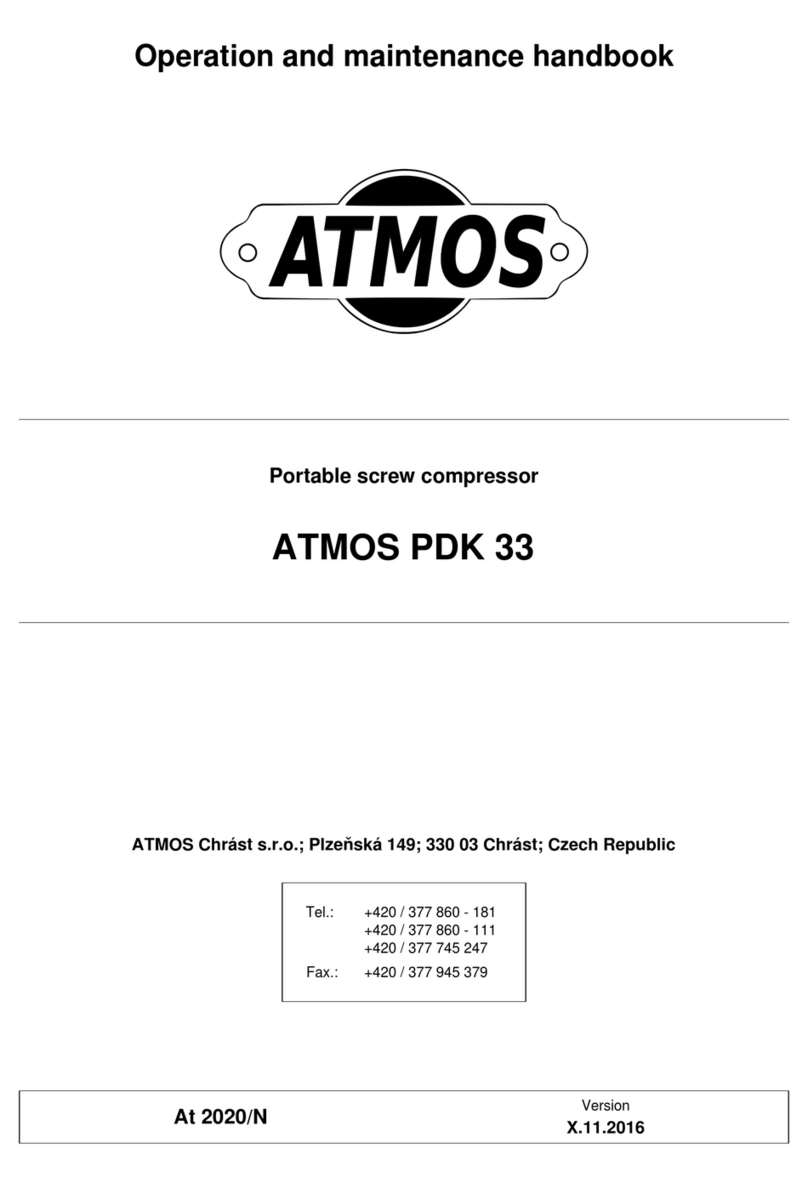
Atmos
Atmos PDK 33 Series Manual
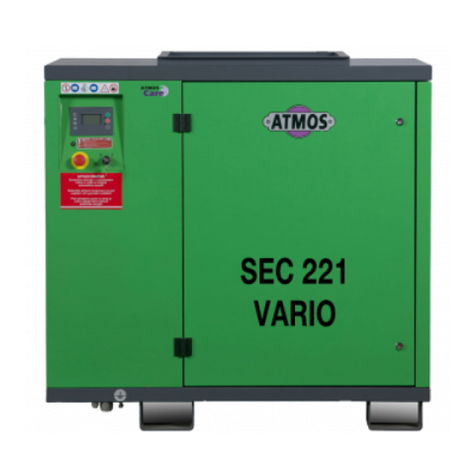
Atmos
Atmos SEC Series Manual
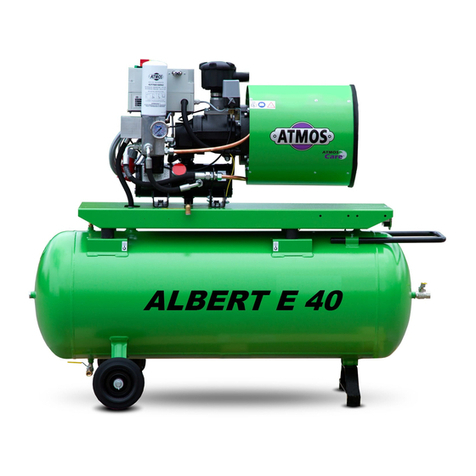
Atmos
Atmos Albert E 40 Manual
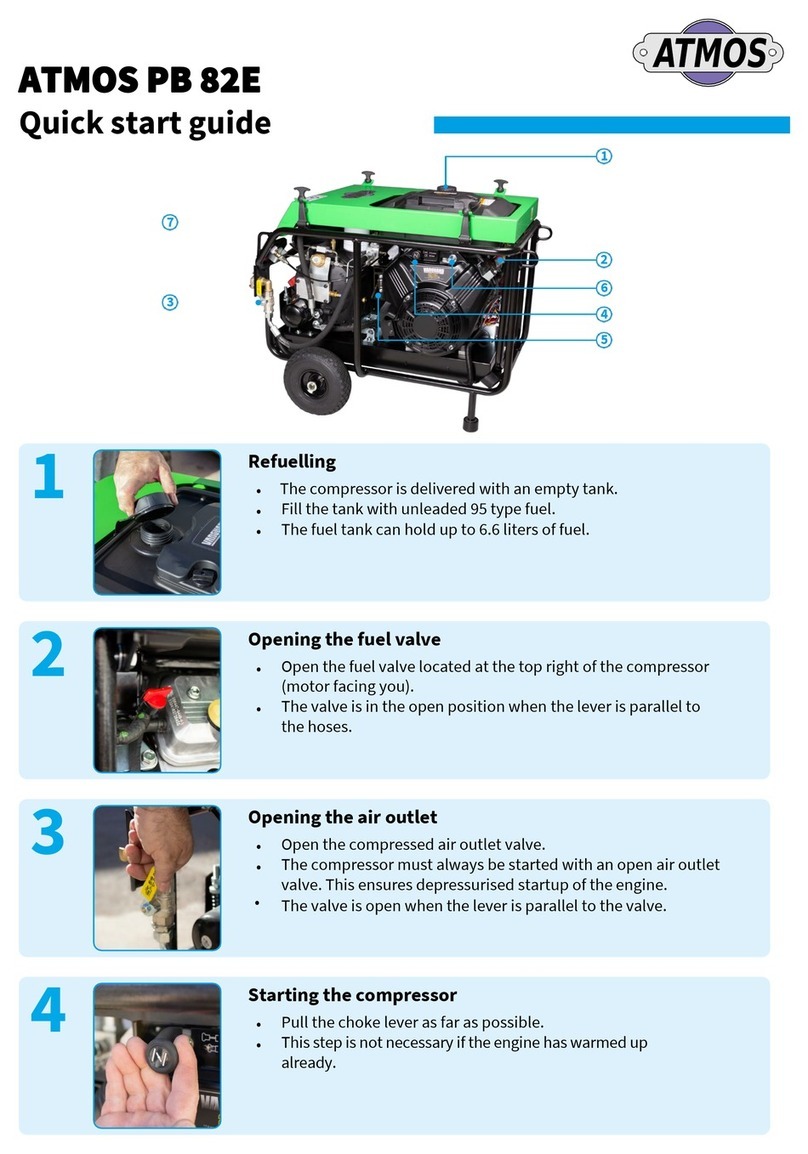
Atmos
Atmos PB 82E User manual

Atmos
Atmos SEC Series Manual
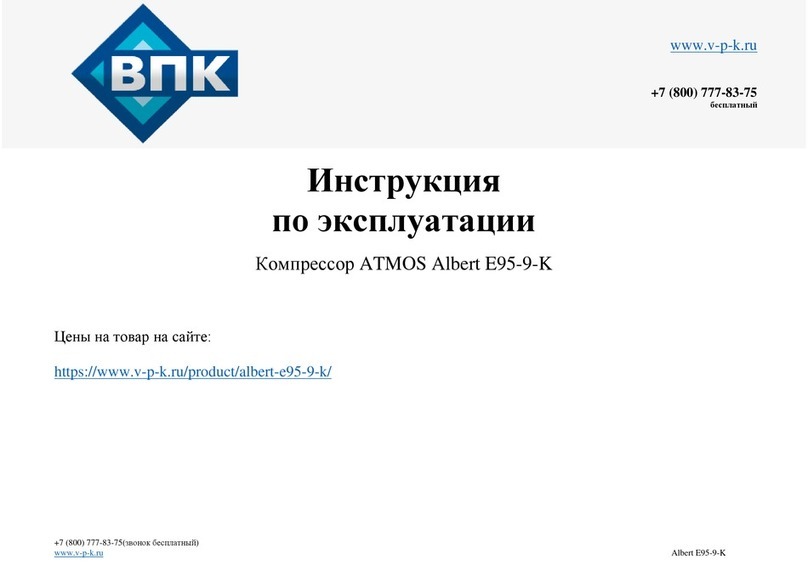
Atmos
Atmos Albert E95-9-K User manual
Popular Air Compressor manuals by other brands

Probuilder
Probuilder 43660 instruction manual
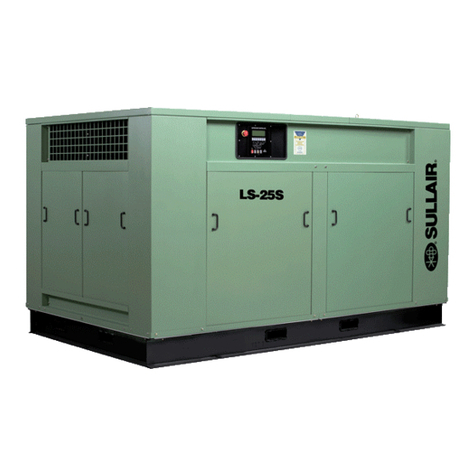
Sullair
Sullair LS-25S-257KW Operator's manual and parts list
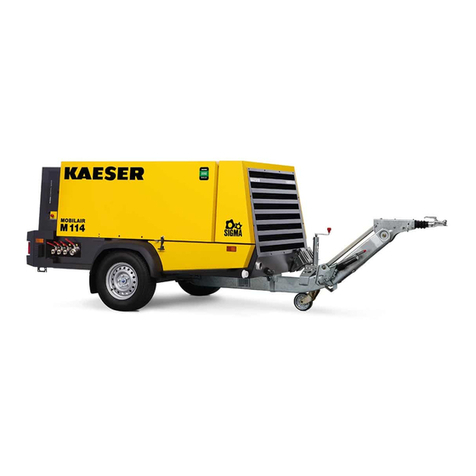
KAESER KOMPRESSOREN
KAESER KOMPRESSOREN SIGMA CONTROL SMART M114 Operator's manual
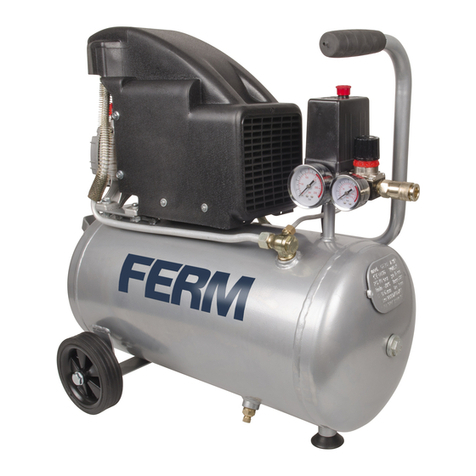
Ferm
Ferm CRM1045 Original instructions
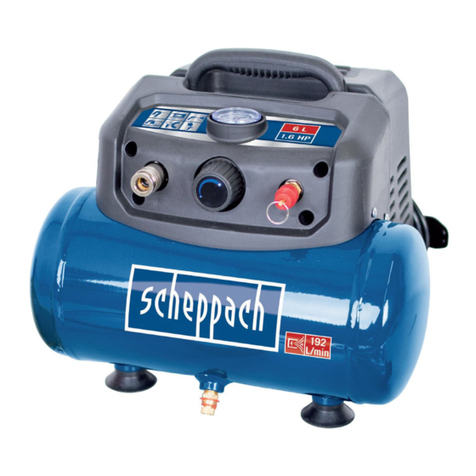
Scheppach
Scheppach HC06 Translation from the original instruction manual

Carrier
Carrier 5H installation instructions
